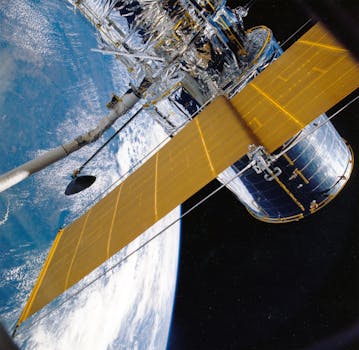The Future of Satellites: Revolutionizing Global Communication and Exploration
The future of satellites is rapidly evolving, with advancements in technology and increasing demand for global communication and space exploration. This article explores the latest developments and innovations in satellite technology, including satellite constellations, satellite-based internet, and the role of satellites in deep space exploration.

The Future of Satellites: Revolutionizing Global Communication and Exploration
The future of satellites is rapidly evolving, with advancements in technology and increasing demand for global communication and space exploration. The future of satellites is closely tied to the concept of satellite technology, which has been revolutionizing the way we communicate and explore space. At the beginning of the 21st century, the use of satellites for communication, navigation, and weather forecasting has become an essential part of our daily lives. As we look to the future, it’s clear that satellites will play an even more critical role in shaping our world.
Satellite technology has come a long way since the launch of the first artificial satellite, Sputnik, in 1957. Today, there are thousands of satellites orbiting the Earth, providing a wide range of services, including communication, navigation, weather forecasting, and Earth observation. The future of satellites is expected to be shaped by several key trends, including the development of satellite constellations, the growth of satellite-based internet, and the increasing use of satellites in deep space exploration.
Satellite Constellations: A New Era in Satellite Technology
Satellite constellations are a network of satellites that work together to provide global coverage and continuous service. These constellations are designed to provide high-speed internet, communication, and navigation services to users around the world. One of the most significant advantages of satellite constellations is their ability to provide coverage in remote and underserved areas, where traditional communication infrastructure is limited or non-existent. Companies such as SpaceX, OneWeb, and Amazon’s Kuiper Systems are leading the charge in developing satellite constellations, with plans to launch thousands of satellites into orbit in the coming years.
The development of satellite constellations is also driving innovation in satellite technology, with advances in areas such as propulsion systems, power generation, and communication protocols. For example, SpaceX’s Starlink constellation uses a phased array antenna system, which allows the satellites to communicate with each other and with ground stations, providing high-speed internet and communication services. The use of satellite constellations is also expected to have a significant impact on the environment, with the potential to reduce the amount of space debris in orbit and provide more efficient and sustainable communication services.
Satellite-Based Internet: Bridging the Digital Divide
Satellite-based internet is another area where satellite technology is making a significant impact. With the launch of satellite constellations, it’s becoming possible to provide high-speed internet services to users in remote and underserved areas. This is particularly important in areas where traditional communication infrastructure is limited or non-existent, such as in rural or developing communities. Satellite-based internet has the potential to bridge the digital divide, providing access to information, education, and economic opportunities to millions of people around the world.
Companies such as SpaceX, OneWeb, and Hughes Network Systems are already providing satellite-based internet services, with plans to expand their coverage and services in the coming years. For example, SpaceX’s Starlink service provides high-speed internet with speeds of up to 1 Gbps, while OneWeb’s constellation is designed to provide low-latency, high-speed internet services to users in remote and underserved areas. The use of satellite-based internet is also expected to have a significant impact on the environment, with the potential to reduce the amount of e-waste generated by traditional communication infrastructure.
The Role of Satellites in Deep Space Exploration
Satellites are also playing a critical role in deep space exploration, providing communication, navigation, and scientific services to spacecraft and astronauts. The use of satellites in deep space exploration is expected to become even more important in the coming years, as space agencies and private companies plan to send humans and spacecraft to the Moon, Mars, and beyond. For example, NASA’s Artemis program is planning to use satellites to provide communication and navigation services to spacecraft and astronauts on the Moon and Mars.
The use of satellites in deep space exploration is also driving innovation in areas such as propulsion systems, life support systems, and radiation protection. For example, the European Space Agency’s (ESA) Hera mission is planning to use a satellite to test the feasibility of a new propulsion system, which could be used to deflect asteroids and other near-Earth objects. The use of satellites in deep space exploration is also expected to have a significant impact on our understanding of the universe, with the potential to provide new insights into the formation and evolution of our solar system and beyond.
Conclusion
In conclusion, the future of satellites is rapidly evolving, with advancements in technology and increasing demand for global communication and space exploration. The development of satellite constellations, the growth of satellite-based internet, and the increasing use of satellites in deep space exploration are just a few examples of the many exciting developments in the field of satellite technology. As we look to the future, it’s clear that satellites will play an even more critical role in shaping our world, providing new opportunities for communication, exploration, and discovery.





